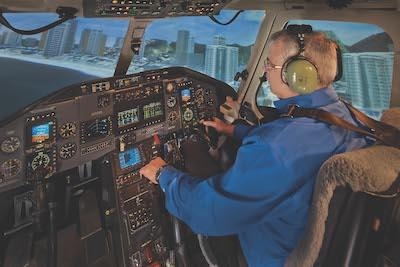Tue, Mar 05, 2019
To Add Advanced Energy Management - Rotorcraft Course
FlightSafety International will add a new Advanced Energy Management – Rotorcraft course to its Master Aviator program for helicopter pilots in the coming months.

"We are pleased to enhance the FlightSafety Master Aviator program for helicopter pilots with this new Advanced Energy Management course," said Steve Gross, Senior vice president, Commercial. "Master Aviator sets a new standard for pilot achievement and recognition, enabling pilots to develop a deeper knowledge of the helicopter they fly, as well as a safe and correct response to a broad range of demanding, unexpected situations."
FlightSafety Master Aviator for helicopter pilots is earned by completing all advanced aircraft- specific core courses and a choice of four electives. At least one FlightSafety initial or recurrent training event must also be completed every 8 months.
The one-day core courses now include Advanced Energy Management - Rotorcraft, Advanced Helicopter Crew Resource Management, and Advanced Helicopter Surviving Inadvertent Instrument Meteorological Conditions.
The Advanced Energy Management course increases a pilot’s understanding of helicopter aerodynamics and introduces techniques to improve control of the helicopter and rotor energy during normal and abnormal operations. Pilots will focus on Crew Resource Management, Energy Situational Awareness and managing the kinetic and potential energy available to them while flying.
The Advanced Crew Resource Management course enables the pilots to master the key aspects of CRM that uniquely apply to helicopter operation. This includes situational awareness, conflict resolution and communication skills. They will also experience how effective crew performance and decision-making can overcome situations caused by error chains, human factors and fatigued or stressed operators.
The inadvertent IMC course will help pilots to be fully prepared when weather conditions unexpectedly and rapidly change in order to have sound and well-practiced strategy to maintain the safety of their aircraft. This course provides the tools needed to react appropriately as decisions made in the first pivotal moments often decide the outcome. Pilots will also review and fully understand the major causes for inadvertent IMC accidents and master best practices for the safest responses.
(Image provided with FlightSafety news release)
More News
Aero Linx: Transport Canada We are a federal institution, leading the Transport Canada portfolio and working with our partners. Transport Canada is responsible for transportation p>[...]
Gross Navigation Error (GNE) A lateral deviation from a cleared track, normally in excess of 25 Nautical Miles (NM). More stringent standards (for example, 10NM in some parts of th>[...]
From AirVenture 2017 (YouTube Edition): Flight-Proven Booster On Display At AirVenture… EAA AirVenture Oshkosh is known primarily as a celebration of experimental and amateu>[...]
Aircraft Parachute System (CAPS) Was Deployed About 293 Ft Above Ground Level, Which Was Too Low To Allow For Full Deployment Of The Parachute System Analysis: The day before the a>[...]
Also: 48th Annual Air Race Classic, Hot Air Balloon Fire, FAA v Banning 100LL, Complete Remote Pilot The news Piper PA-18 Super Cub owners have been waiting for has finally arrived>[...]
 ANN's Daily Aero-Linx (06.29.25)
ANN's Daily Aero-Linx (06.29.25) ANN's Daily Aero-Term (06.29.25): Gross Navigation Error (GNE)
ANN's Daily Aero-Term (06.29.25): Gross Navigation Error (GNE) Classic Aero-TV: Anticipating Futurespace - Blue Origin Visits Airventure 2017
Classic Aero-TV: Anticipating Futurespace - Blue Origin Visits Airventure 2017 NTSB Final Report: Cirrus SR22
NTSB Final Report: Cirrus SR22 Airborne Affordable Flyers 06.26.25: PA18 Upgrades, Delta Force, Rhinebeck
Airborne Affordable Flyers 06.26.25: PA18 Upgrades, Delta Force, Rhinebeck



